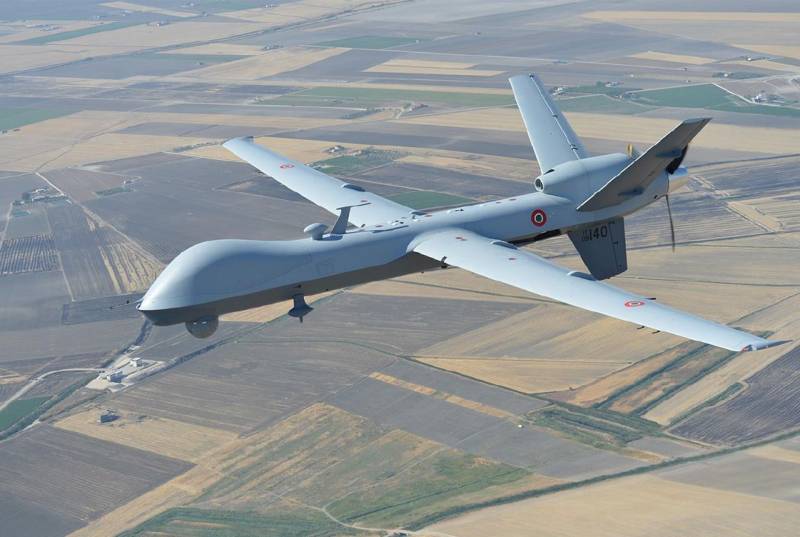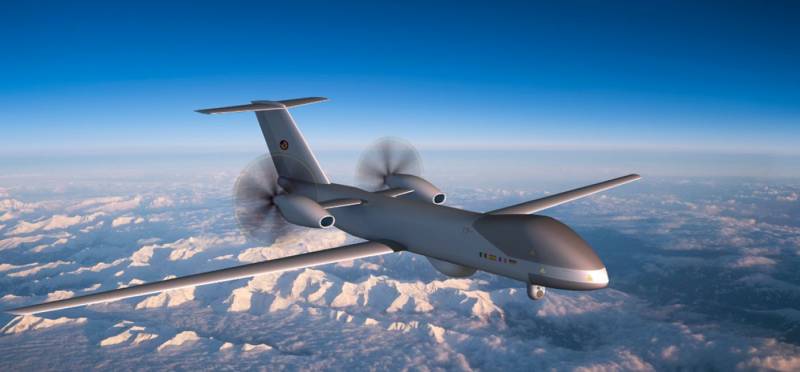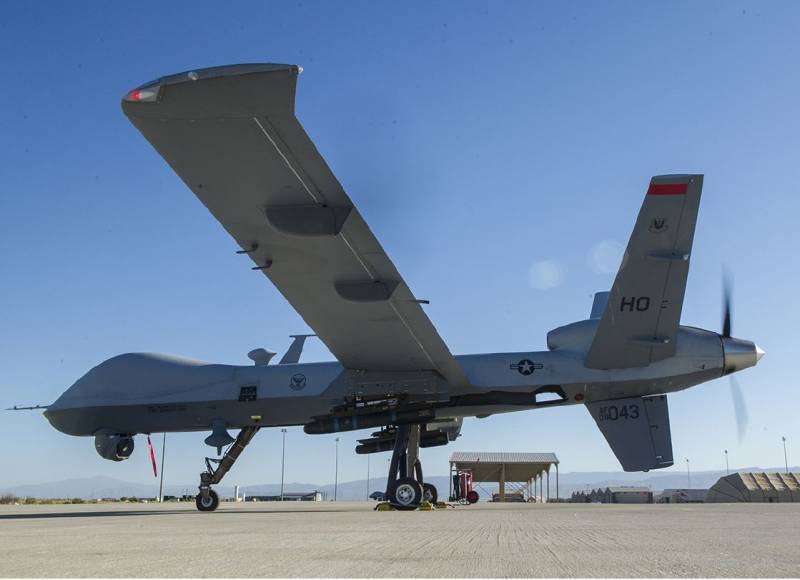Status and prospects of the global market for MALE drones
The global market for UAVs of the MALE class (Medium Altitude Long Endurance - medium-altitude, long-duration flight) is now turning into a site of fierce trilateral competition between suppliers from the United States, Israel and China. Since these technologies are already reaching the level of the fifth generation, we will analyze how cost, opportunities and export controls affect the choice of those who want to buy these Drones.
Since the 90s, when the General Atomics Aeronautical Systems (GA-ASI) MQ-1/9 Predator / Reaper drones were first used in the conflicts of the former Yugoslavia, the MALE UAVs (some of them were able to carry bombs and missiles) changed conducting combat operations, performing tasks such as reconnaissance and surveillance, direct aviation support and relay communications.
The United States and Israel pioneered the development and use of these platforms, and this was not a simple adaptation. The U.S. Army Secretary said September 2019:
Expansion
Deployment of UAVs, including MALE class drones, is ongoing worldwide. These systems were used by all parties to the conflict in the Caucasus, Iraq, Libya, Syria and Yemen, and most often with armed load.
According to reports, in 2008-2018, Israel exported 167 MALE drones, mainly IAI Heron and Elbit Hermes, in addition to those manufactured for its own armed forces. The country also exported UAV production technologies to Azerbaijan, Brazil, Kazakhstan and Turkey.
From 2008 to 2018, China exported about 163 MALE drones capable of carrying weapons. Its CASC Corporation CH-3/4 Rainbow drones were sold to Algeria, Ethiopia, Iraq, Jordan, Myanmar, Nigeria, Pakistan, Saudi Arabia, Turkmenistan, the UAE and Zambia, while the first two CH-4 drones from an Indonesian order were delivered in September 2019, which marked the beginning of penetration into the market of this country. A modernized version of the CH-5 is offered to many countries, and therefore China has expanded production capacity at a highly automated enterprise in Taizhou, which is reportedly capable of producing 200 UAVs per year.
UAV MALE WING Loong I / II UAVs of the AVIC corporation (the export version of the Gong-ji GJ-1 is operated by the Chinese military) have been offered on the foreign market since 2014, along with weapon sets and sensors for them. The sale of Wing Loong II drones to an unnamed customer in 2017 was announced as the largest single purchase of Chinese weapons at that time. According to reports, the new Chinese UAV with a twin keel tail Tengden TB001, a prototype of which took off in 2019, is being developed.
China, along with the platforms themselves, also exported technologies, an agreement was signed with the Saudi company King Abdulaziz City for Science and Technology on the licensed production of CH-4 and other models. The Saqr 1 MALE class drone, considered a local project, borrowed technology from Chinese and other sources.
China sells MALE drones about four times cheaper than Predator / Reaper drones in a complete set (4-16 million dollars) and without restrictions imposed by the Americans. But not all users were apparently satisfied with this; Jordan has put up some of its UAVs for resale. Some Chinese export deals, such as sales of Saudi Arabia and the UAE, were completed only after the United States rejected requests for weapons-grade Predator / Reaper options. “Unfortunately, the spread of Chinese UAVs means that every such sale will have a great impact on the demand for our country to remain in this area,” said the president of the Aerospace Industry Association last year. “We cannot vow to promise that we will always be the preferred partner.”
Hoping for your strength
Other countries are full of ambitious plans, seeking to significantly increase export sales. For example, the UAV Yabhon United 40 (Smart Eye 1) UAE was sold to Nigeria, Russia and other customers, and Algeria received the Smart Eye 2 option. UAEs also offer technology transfer and participation in R&D; Malaysia is one of those countries that jointly develop UAV technologies.
Turkey, which has received Israeli UAV technology in the past, has not made much progress in exporting its TAI Anka / Aksungar drones. A presidential decree on the allocation of funding, published in September 2019, identified the development of UAVs as a particularly high priority. The agreement concluded in 2018 with the Indonesian company PTDI included the development of the Elang Hitam platform (Black Eagle) based on the Turkish drone Anka.
The Orion UAV of the Russian company Kronstadt Group has experience in combat use in Syria and Ukraine. In 2019, the first foreign order was received from an unnamed Middle East country for the Orion-E option.
Korean companies, united in the Aerospace Industry Association, have developed several MALE UAVs: Next Generation Corps-level UAV, Next-Generation Corps-level UAV, Division-level UAV and Medium Altitude Endurance UAV (as we see, Koreans before entering the international market not particularly puzzled by its designation). The sensor kit integration agreement was announced by Korean Air and Raytheon in October 2019. The increasing importance of MALE platforms reflects the 2018 agreement with North Korea, which does not allow flights of such UAVs at a certain distance from the demilitarized zone.
India is developing the Rustom-2 drone, which first took off in 2016. It is reported that the development of this project is quite sluggish, in addition, one of the six prototypes crashed in November 2019.
Iran produces its own Shahed 129 UAV, which can carry weapons and, according to some, includes technologies of Chinese and Israeli origin. Iran pays special attention to the development and deployment of UAVs in order to compensate for the restrictions associated with the use of its obsolete manned combat aircraft.
Although a number of European military structures currently use MALE class UAVs of American and Israeli origin, France, Germany Italy and Spain are implementing the Euro MALE project (formerly MALE 2020) with the active participation of Airbus, Dassault and Leonardo. Its configuration provides for the installation of two engines in order to meet German safety requirements. It was reported that the drone will be ready for flight in 2024 and will go into service in 2027-2029, while the production of the Falco Xplorer - the MALE drone based on the Leonardo Falco series - can begin as early as 2020.
Under control?
The spread of the MALE class UAV in the world for the most part occurred without the participation of well-known aerospace companies from the USA, Europe or Russia, despite the fact that they dominate the global military aviation markets. To some extent, this reflects the limitations imposed by the terms of the Missile Technology Control Regime (MTCR). Since its inception in 1987, members of the MTCR have not distinguished UAVs from missiles that must be controlled if they (drones) comply with stringent limits on range and load.
Category I systems (with a range of over 300 km and a carrying capacity of over 500 kg) were the subject of an “absolutely strict presumption of an export ban." MALE UAVs fall into this category, for example, the Predator / Reaper series drones and most Heron models, as well as drones. incapable of carrying weapons, such as Orion from Aurora Flight Systems. As a result, “the MTCR partners are largely deprived of most of this booming market, they are unable to take full advantage of the commercial advantages of this growing sector due to the high barriers imposed by the presumption of failure of the MTCR for all Category I systems” (from a statement by the Assistant Secretary of State, February 2019).
Although Predator XP, as well as some of the Heron and Hermes variants with poor performance, were assigned to category II, they also face limitations of MTCT. The ban on the sale of UAV MALE to allies (even those who are allowed to buy combat aircraft) was perceived as a kind of distrust.
However, the export of UAV MALE from manufacturers that are not included in the MTCR is not limited to its conditions. A spokesman for the Department of Defense’s Military Cooperation Office said these restrictions discredit US security and cooperation policies and that “security cooperation is our top priority trust building tool.”
Since the meeting of the MTCR members in 2018, the United States has led efforts to distinguish between missiles and UAVs and to exclude the latter from Category I. The National Security Memorandum, published in April 2018, approved a revised strategy aimed at expanding the supply of conventional weapons by the United States (including UAVs MALE) and counteracting shipments from China and other countries outside the MTCR.
This expansion of the range of supplies of conventional weapons for the first time made possible direct commercial sales of UAVs. Previously, all such transactions were supposed to take place under the Sale Act. weapons and military equipment to foreign countries. It also changed the interpretation of drones capable of using a laser target designator, allowing them to be placed in the same category as unarmed aircraft.
The United States has tightened end-use monitoring and policies banning the arming of UAVs, which were sold without the ability to carry bombs and missiles. In April 2018, the director of the National Trade Council called these changes "an important catalyst for strengthening American industry, organizing our national security and strengthening our international cooperation."
Under the Obama administration, exporting armed MALE UAVs was difficult even for close US allies, and was almost impossible to other countries. Since February 2015, unarmed MALE UAVs have been transferred to a wider group, subject to guarantees of proper intended use. This meant a change in previous policies that limited the export of Reaper armed drones to the UK. The 2015 doctrine actually banned the export of UAV MALE to existing allies of the United States.
Possible use cases
India can set a precedent if the first delivery of American UAVs MALE to a customer who is not a contract partner takes place; the country was adopted by the 35th member of the MTCR in 2016. In order to meet the needs of the Indian armed forces in the UAVs of the MALE category, Israel, for its part, has proposed a revised version of the Heron TR XP, which meets the definitions of category II of the MTCR and will not have American components.
But Delhi still requested 22 Guardian UAVs (unarmed Reaper versions) of GA-ASI from the United States. However, he did not request technology transfer and partial localization of production, although this has always been an important element of aviation procurement in the past. A spokesman for the State Department said last fall that “co-production is not a reason for partners to break their lasting strong relationship.”
A possible change in the policy of joint production may reflect the current struggle for the order of Malaysia, which provides for the supply of about six aircraft. This is currently the first direct competition between the Guardian, Wing Loong II, CH-5, Anka and Falco drones. The representative of the Department of State expressed the view that the US strategy should reflect that when selling
Despite a softening policy in 2018, a GA-ASI spokesman said:
The policy of 2018 did not remove many other barriers to the export of American drones, with some of them not agreeing with other members of the MTCR. “The Law on Countering America’s Adversaries through Sanctions” defined the US’s reluctance to export any sensitive technology to countries buying Russian weapons. Its influence - not yet directly applicable to the MALE UAV - was demonstrated by disagreeing with Turkey over its purchase of Russian S-400 anti-aircraft systems.
In this context, the list of countries in the United States Trade Representation that are unable to provide adequate protection for intellectual property includes many states involved in the production and purchase of MALE drones. The export control of the Wassenaar Arrangement for conventional weapons and dual-use goods and technologies could also get in the way of such countries. The United States is interested in keeping all of this up to date so as not to have problems with the export of dual-use technologies to China.
Advanced control
One of the potential ways for the victory of free from regulation market participants with cheaper products is to offer options with improved technology that are not affected by the MTCR rules. One of the most significant upgrades to the future capabilities of the MALE UAV is the ability to fly through and operate in a controlled airspace using a system for detecting and preventing collisions in the air. This is especially important for maritime operations in international airspace and at lower altitudes (which led to the installation of anti-icing, lightning protection and updated avionics systems). But the use of over-the-horizon channels for communication with control stations in the absence of reliable satellite communications remains a big problem.
The GA-ASI-developed airspace control system was deployed on non-military government UAVs and then exported to the Guardian drones. GA-ASI's Reaper UAV Reaper UK program by 2024 reflects the need for such capabilities. MALE UAVs using this system pass civil certification in the US and the UK, a step that the company calls the “future of unmanned aircraft”.
China says its export UAVs are already capable of operating in a controlled airspace, while the UAE is developing a similar system and is offering to work together with foreign partners to market its MALE-class platforms. For its part, Israel has proposed a communications interface between air traffic control and ground-based drone control stations and offers these export options.
Declaration of independence
Promising UAVs MALE, especially those designed for marine and expeditionary operations, can use a rotary screw or similar design for vertical take-off and landing. MUX (Marine UAV Experimental) is expected to pass tests in the US Marine Corps in the mid-2020s, where it will evaluate the capabilities of this platform, which can operate from landing ships and prepared sites on the coast, having reduced requirements for logistics, space on deck (always in short supply on a warship) and headcount. The Bell V-247 Vigilant unmanned convertiplane, for example, has folding wings and can fit in ship's hangars for helicopters.
Today, another important factor is survivability, since the situation in Afghanistan and Iraq, where air defense systems were practically absent, is unlikely to happen again. According to Ukraine, at least 2014 Russian Orion UAVs of the MALE class were shot down over its territory in 2018-10, including one that was shot down by a Mi-24 attack helicopter. In December 2019, Russian air defense systems also shot down two drones over Libya: the Italian Reaper and an undefined U.S. model of production.
To ensure that Reaper drones can stay out of missile defense, GA-ASI is developing an independent Sparrowhawk project. This is a small UAV weighing 91 kg, which can be launched and returned during the flight, refuel and re-launched, which will allow the UAV MALE to become carriers. Tests of the prototype are scheduled to begin this year.
Enhanced surveillance and intelligence capabilities
Another problem associated with the UAV MALE is information overload. They can transmit such a volume of sensory data (especially full-frame video of cinematic quality) that exceeds the ability of users to analyze it. In conflicts in Afghanistan and Iraq, such a large amount of video was provided to the commanding staff (making it possible to directly observe military operations at a great distance), for which it received the nickname "Predator porn" from the US military. According to some estimates, 85% of the video collected in this way was not used and remained unclaimed in the lower echelons.
In order to solve the problem, in April 2017, the United States launched the Maven project, the first practical use of which in combat conditions occurred in 2018. It uses artificial intelligence along with advanced machine learning to analyze video flow. After initial testing on a TUAS special forces UAV in 2019 as part of the Agile Condor program, the developed software was used to analyze sensor flows from Predator / Reaper drones. “We worked closely with the Special Operations Forces in order to understand how to automate manual tasks and gain opportunities with a higher level of autonomy,” said the US Air Force spokesman.

The Italian drone MQ-9 Reaper cannot carry weapons. Its export was impossible until the revision of the MTCR policy in 2015
But artificial intelligence (AI) can potentially revolutionize far more than an analysis method. It allows you to create “smart” networks, including UAVs, changing their communication channels and flight paths for rapidly changing situations and threats, and also makes it possible to carry out operations with a higher level of autonomy.
Cloud-based capabilities allow you to get away from the direct transmission model of full-frame video from a UAV and move to a limited number of receiving elements - for example, a headquarters or an airplane, which better meets the user's needs and rapidly changing operational requirements. Former Under Secretary of Defense Robert Wark once said that “cloud technologies have excellent innovative capabilities in the military, along with the potential for use in the Third Counterweight Strategy, affecting almost all aspects of military operations.”
A cloud with integrated AI can replace the direct Predator porn video from drones with a data stream of the correct volume, which contains all the necessary information without overloading or confusing an individual user.
The development of AI potential, aimed at a radical change in UAV operations, is not only in the United States. A Boeing Australia spokesman said in September 2019 that “they will develop and test cognitive AI algorithms so that they can collect information in a denied access environment and perform improved tactical actions in a hostile space.”
The United Arab Emirates also sees AI technology as a priority, while China's strong AI expertise brings potential benefits to overseas customers. The US Secretary of Defense said on this occasion that “Chinese arms manufacturers are selling drones, claiming their autonomy, including the ability to deliver targeted lethal strikes."
Network future
The chief of staff of the US Air Force, in turn, noted: “The future war will not be won by platforms, it will be won by networks. We must emphasize the network-centric approach. ”
If the United States can convince potential customers that the UAVs they export will increase the level of network-centricity in hostilities, this could be the most reliable barrier to the spread of MALE-class UAVs from non-MTCR manufacturers.
For decades, the United States has built a model of effective online military operations in which MALE drones have an important role to play. Competitors have demonstrated the ability to supply similar devices, but still not with the level of network interaction that would call them truly effective. Over the coming decades, in the United States and some other countries, MALE-class drones are likely to retain their status as a key component of combat networks.



Information